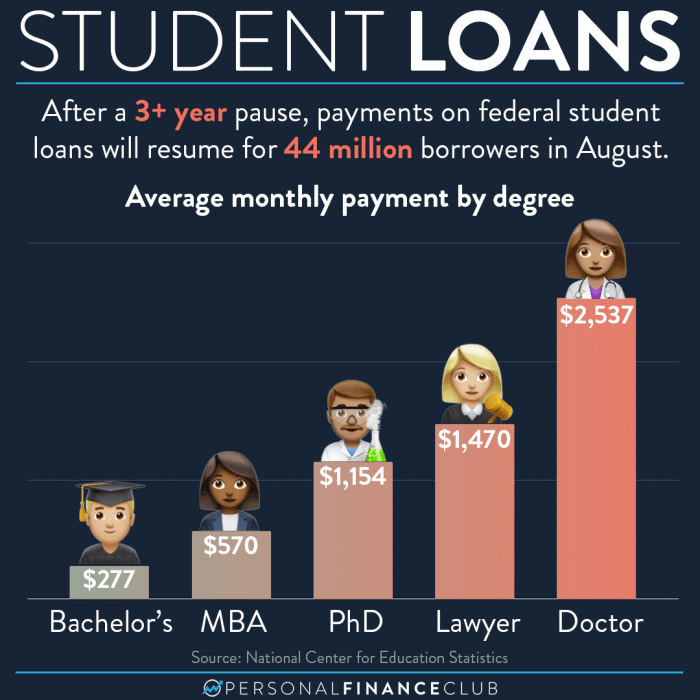
Navigating the world of student loan repayment can feel like deciphering a complex financial code. The question, “How much do you pay on student loans a month?” is a common one, and the answer is far from simple. It depends on a multitude of factors, from your initial loan amount and interest rate to the repayment plan you choose. This guide will unravel the intricacies of student loan payments, empowering you to understand your obligations and make informed decisions about your financial future.
We’ll explore the key elements influencing your monthly payment, providing clear explanations and practical examples. We’ll also delve into various repayment strategies, helping you determine the best approach for your unique circumstances. Whether you’re facing repayment soon or are still planning your educational journey, this comprehensive resource will provide the knowledge you need to manage your student loan debt effectively.
Factors Influencing Monthly Student Loan Payments
Calculating your monthly student loan payment involves several key factors. Understanding these factors allows for better financial planning and informed decision-making regarding repayment strategies. The primary determinants are the loan principal, interest rate, loan term, and the chosen repayment plan.
Loan Principal, Interest Rate, and Loan Term
The loan principal is the original amount borrowed. The interest rate represents the cost of borrowing that money, expressed as a percentage. The loan term is the length of time you have to repay the loan. These three factors are directly related to your monthly payment. A higher principal, higher interest rate, or shorter loan term will all result in a larger monthly payment. Conversely, a lower principal, lower interest rate, or longer loan term will result in a smaller monthly payment.
Impact of Different Interest Rates on Monthly Payments
Let’s illustrate the impact of interest rates with examples. Assume a $20,000 loan principal and a 10-year loan term.
With a 5% interest rate, the approximate monthly payment would be $212. However, if the interest rate were 7%, the monthly payment would increase to approximately $238. A seemingly small increase in the interest rate significantly impacts the monthly payment over the life of the loan. This demonstrates the importance of securing the lowest interest rate possible when taking out student loans.
Repayment Plan Options and Their Effects
Different repayment plans offer varying monthly payments and total repayment costs. The choice depends on individual financial circumstances and priorities. The standard repayment plan, extended repayment plan, and income-driven repayment plans are common options.
| Repayment Plan | Monthly Payment Example | Total Repayment Cost Example | Advantages/Disadvantages |
|---|---|---|---|
| Standard Repayment | $500 | $30,000 | Advantages: Faster repayment, lower total interest paid. Disadvantages: Higher monthly payments may be difficult to manage. |
| Extended Repayment | $300 | $36,000 | Advantages: Lower monthly payments. Disadvantages: Longer repayment period, higher total interest paid. |
| Income-Driven Repayment (IDR) | $200 (variable) | Variable, potentially higher total interest paid | Advantages: Payments are based on income and family size, making them more manageable. Disadvantages: Payments can be lower, leading to a longer repayment period and higher total interest paid. |
Calculating Monthly Student Loan Payments
Accurately calculating your monthly student loan payment is crucial for effective budgeting and financial planning. Understanding the factors involved and the methods for calculation empowers you to make informed decisions about your repayment strategy. This section will guide you through manual calculation using the standard amortization formula, explore online calculator tools, and illustrate the impact of loan term on monthly payments and total interest.
Manual Calculation Using the Amortization Formula
The standard amortization formula provides a precise calculation of monthly payments. While online calculators are convenient, understanding the underlying formula offers valuable insight into the mechanics of loan repayment. The formula is:
M = P [ i(1 + i)^n ] / [ (1 + i)^n – 1]
Where:
* M = Monthly payment
* P = Principal loan amount
* i = Monthly interest rate (Annual interest rate divided by 12)
* n = Total number of payments (Loan term in years multiplied by 12)
Let’s break down the calculation step-by-step:
1. Determine the principal loan amount (P): This is the total amount you borrowed.
2. Find the annual interest rate: This is the interest rate stated on your loan documents.
3. Calculate the monthly interest rate (i): Divide the annual interest rate by 12. For example, a 5% annual interest rate becomes 0.05/12 = 0.004167 monthly.
4. Calculate the total number of payments (n): Multiply the loan term (in years) by 12. A 10-year loan has 120 payments (10 * 12).
5. Apply the formula: Substitute the values of P, i, and n into the formula and solve for M. This requires careful attention to order of operations. Many calculators have built-in functions to simplify this process.
Using Online Student Loan Calculators
Numerous free online student loan calculators are available. These calculators simplify the process by requiring you to input the loan amount, interest rate, and loan term. Popular examples include calculators offered by financial websites like Bankrate, NerdWallet, and Sallie Mae. These calculators not only determine your monthly payment but often provide an amortization schedule, detailing the principal and interest portions of each payment over the loan’s life. They often also allow you to explore “what-if” scenarios by changing variables like loan term or interest rate to see how those changes impact your monthly payment and total cost.
Illustrative Example: Impact of Loan Term
The following example demonstrates how changing the loan term affects monthly payments and total interest paid. Consider a $20,000 loan with a 5% annual interest rate.
- 10-Year Loan Term: Using the amortization formula (or an online calculator), the monthly payment would be approximately $212.47. The total interest paid over the 10 years would be approximately $5,496.40.
- 20-Year Loan Term: Extending the loan term to 20 years lowers the monthly payment to approximately $126.53. However, the total interest paid increases significantly to approximately $15,567.20.
This illustrates a critical trade-off: a longer loan term reduces monthly payments but substantially increases the total interest paid over the life of the loan.
Managing Student Loan Debt

Effectively managing student loan debt requires a proactive and organized approach. This involves creating a realistic budget, understanding the potential long-term financial implications, and exploring available resources should you encounter difficulties. Strategic planning is key to minimizing the burden of student loan payments and achieving other important financial goals.
Successfully navigating student loan repayment necessitates a comprehensive strategy encompassing budgeting, financial goal prioritization, and awareness of available assistance programs. Failing to address student loan debt effectively can significantly hinder progress towards other financial aspirations, such as homeownership or retirement planning.
Budgeting and Managing Monthly Student Loan Payments
Creating a detailed budget is crucial for managing student loan payments. This involves tracking all income and expenses to identify areas where savings can be maximized. Prioritizing student loan payments within the budget ensures timely repayment and avoids late fees or negative impacts on credit scores. Consider using budgeting apps or spreadsheets to monitor your finances effectively. For example, a borrower might allocate 20% of their monthly income towards student loan repayment, adjusting this percentage based on their overall financial situation and loan terms. This approach allows for consistent payments while still allowing for other essential expenses and savings goals.
Impact of Student Loan Debt on Other Financial Goals
Student loan debt can significantly impact other financial goals, especially saving for a down payment on a house or retirement. High monthly payments can reduce the amount of money available for saving and investing. For instance, someone with substantial student loan debt might delay purchasing a home or contributing to a retirement account, potentially impacting their long-term financial security. It’s important to carefully balance loan repayment with other financial priorities, perhaps prioritizing high-interest debt while simultaneously making smaller, consistent contributions to savings accounts. Careful financial planning and potentially adjusting your financial goals to accommodate the debt is often necessary.
Resources for Borrowers Struggling with Student Loan Payments
Several resources are available to borrowers facing difficulties with student loan payments. The federal government offers various programs, including income-driven repayment plans that adjust monthly payments based on income and family size. These plans can lower monthly payments but may extend the repayment period. Non-profit organizations also provide guidance and support to borrowers, offering free financial counseling and debt management strategies. Examples include the National Foundation for Credit Counseling (NFCC) and the United Way. Borrowers should explore these resources to find the best option for their individual circumstances. Seeking professional financial advice can also prove beneficial in developing a tailored repayment plan.
The Impact of Interest Rates on Long-Term Costs

Understanding the effect of interest rates on your student loans is crucial for planning your repayment strategy and minimizing long-term costs. Even small differences in interest rates can significantly impact the total amount you pay over the life of your loan. This section will explore how interest rates influence your overall debt burden and the importance of understanding compound interest.
The long-term effects of varying interest rates on total loan cost are substantial. Consider two scenarios: a loan with a 5% interest rate and another with a 7% interest rate, both for $20,000 over 10 years. The higher interest rate will result in a considerably larger total repayment amount.
Compound Interest and its Impact on Student Loan Debt
Compound interest is the interest calculated on both the principal amount and accumulated interest from previous periods. This means that you pay interest on your interest, leading to exponential growth of your debt over time. For student loans, this effect is amplified over the loan’s lifespan, potentially adding thousands of dollars to the total repayment amount. For instance, a $10,000 loan with a 6% annual interest rate compounded monthly will accumulate significantly more interest than a loan with simple interest (interest calculated only on the principal). The more frequent the compounding (monthly, quarterly, daily), the faster the debt grows.
Comparison of Fixed and Variable Interest Rates
A fixed interest rate remains constant throughout the loan’s term, providing predictability in monthly payments. A variable interest rate fluctuates based on market conditions, offering potentially lower initial payments but carrying the risk of significantly higher payments in the future if interest rates rise. A graph illustrating this would show two lines: one representing a fixed-rate loan with a steady, upward sloping line reflecting consistent monthly payments accumulating to the total loan cost. The second line, representing a variable-rate loan, would show a more erratic upward trend, potentially starting lower than the fixed-rate line but potentially surpassing it if interest rates increase during the loan term. The area between the two lines visually represents the difference in total cost over the life of the loan. The x-axis would represent the loan repayment period (in months or years), and the y-axis would represent the cumulative amount repaid. The difference in the total area under each curve highlights the substantial cost differences that can arise from seemingly small differences in initial interest rates. The steeper the slope, the faster the debt grows due to the effects of compound interest.
Exploring Repayment Options
Navigating the landscape of student loan repayment can feel overwhelming, given the variety of plans available. Understanding the differences between these options is crucial for borrowers to choose a plan that aligns with their financial situation and long-term goals. Selecting the right repayment plan can significantly impact your monthly payments, total interest paid, and overall repayment timeline.
Choosing the best repayment plan involves careful consideration of your income, debt load, and financial goals. Each plan offers a unique set of benefits and drawbacks, and the optimal choice will vary depending on individual circumstances. The following Artikels several common repayment plans and their key characteristics.
Standard Repayment Plan
The standard repayment plan is the default option for most federal student loans. It typically involves fixed monthly payments over a 10-year period. This plan offers predictable payments but may result in higher overall interest payments compared to income-driven repayment plans.
Extended Repayment Plan
This plan extends the repayment period beyond the standard 10 years, offering lower monthly payments. However, the extended repayment period leads to significantly higher total interest paid over the life of the loan. The maximum repayment period varies depending on the loan amount.
Graduated Repayment Plan
Under a graduated repayment plan, monthly payments start low and gradually increase over time. This option can be appealing in the early stages of a career when income is typically lower. However, borrowers should be aware that payments will become substantially higher later in the repayment period.
Income-Driven Repayment (IDR) Plans
IDR plans tie monthly payments to a borrower’s income and family size. Several types of IDR plans exist, including Income-Based Repayment (IBR), Pay As You Earn (PAYE), Revised Pay As You Earn (REPAYE), and Income-Contingent Repayment (ICR). These plans typically offer lower monthly payments than standard repayment, potentially leading to loan forgiveness after 20 or 25 years, depending on the plan and eligibility. However, longer repayment periods mean higher overall interest costs.
| Repayment Plan | Eligibility Requirements | Payment Calculation Method | Key Features |
|---|---|---|---|
| Standard Repayment | Most federal student loans | Fixed monthly payment over 10 years | Predictable payments, shorter repayment period, higher total interest |
| Extended Repayment | Most federal student loans | Fixed monthly payment over a longer period (up to 25 years) | Lower monthly payments, significantly higher total interest |
| Graduated Repayment | Most federal student loans | Payments start low and increase gradually | Lower initial payments, higher payments later in repayment, higher total interest |
| Income-Driven Repayment (IDR) Plans (IBR, PAYE, REPAYE, ICR) | Federal student loans; income and family size verification required | Based on discretionary income and family size | Lower monthly payments, potential for loan forgiveness after 20 or 25 years, higher total interest due to longer repayment |
Ultimate Conclusion

Understanding how much you’ll pay on your student loans each month is crucial for effective financial planning. By carefully considering the factors Artikeld in this guide—loan principal, interest rates, repayment plans, and long-term costs—you can develop a sustainable repayment strategy. Remember to utilize available resources and explore all your repayment options to find the best fit for your individual financial situation. Taking proactive steps towards managing your student loan debt will pave the way for a more secure and prosperous future.
FAQ Compilation
What happens if I miss a student loan payment?
Missing a payment can lead to late fees, damage your credit score, and potentially result in default, which has serious consequences.
Can I refinance my student loans to lower my monthly payment?
Refinancing is a possibility, but it depends on your credit score and the current interest rates. It might lower your monthly payment but could extend the repayment period.
Are there any programs that can help me reduce my student loan payments?
Yes, several government programs and non-profit organizations offer assistance, such as income-driven repayment plans and loan forgiveness programs for specific professions.
How do I choose the right repayment plan?
Consider your current financial situation, long-term goals, and the total cost of repayment under each plan. A financial advisor can help you make this decision.
